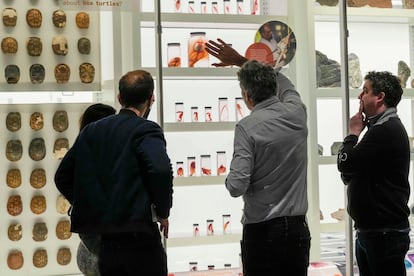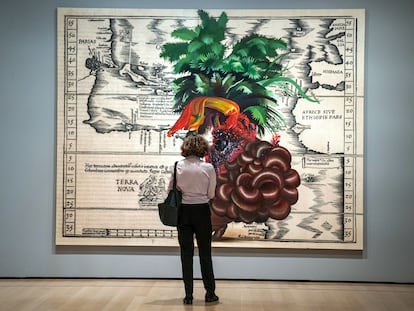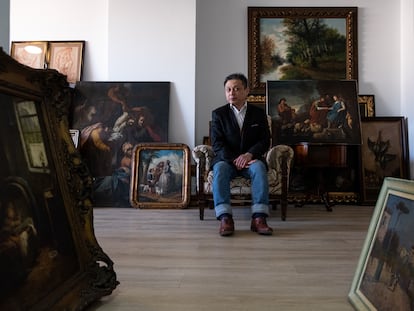Renovation of the American Museum of Natural History in New York includes sustainable architecture, interactive tools
The institution’s newest wing – home to a center for education and research – took 10 years to build and cost $465 million


In full view of the public, a diligent procession of ants carries leaves and grains on a tiny, glass-protected walkway. Meanwhile, a Hercules beetle stretches in slow motion, with mechanical movements, on a nearby panel. Hundreds of butterflies – belonging to 80 different species – are concentrated in a humid tropical enclosure, most of them fluttering low, settling on leaves, or sipping the juice of citrus slices (part of their daily rations).
None of these creatures notice the human beings who – after walking through a double door, designed to prevent the butterflies from escaping – surrender to the wonderful colors of the wings. In an exhibit titled Invisible Worlds – an immersive, 360-degree experience that recreates the development and future of the universe in just over 10 minutes – the public receives oodles of information, light and colors.
These are just some of the main attractions of the new wing of the American Museum of Natural History, located in the Upper West Side of Manhattan. The institution is among the most popular in the city, having received five million visits each year before the pandemic.
The Richard Gilder Center for Science, Education, and Innovation is the latest addition to the 10 buildings which make up the museum, which was founded in 1869.

Unlike the older rooms, the Gilder Center is the advent of a new era. After 10 years of work and an investment of $465 million, the American Museum of Natural History has put together a modern, interactive platform, all within an internationally-acclaimed building that is considered to be a great architectural achievement. So astounding is the structure that it has raised a question that is frequently asked in discussions about contemporary museums: whether or not the package outshines the content.
The scientific character of the center – with next-generation classrooms and a macro data center – goes hand-in-hand with its obligatory function as a place that hosts exhibitions. However, of the four million pieces that the museum houses, only about 30,000 are exhibited to the public. From now on, the virtual dimensions of the new building – equipped with touch panels for visitors – will show the vast majority of the collection. The museum’s leadership is clearly committed to telling the natural history of the world, from dinosaurs to galaxies… but in a contemporary context.
The building – designed by Studio Lang – has angered some of the area’s residents, who saw part of an adjoining park taken up by the expansion. It is flooded with natural light, with skylights dotting the main hall, which resembles a kind of canyon. Diagonal patterns evoke the phenomenon of geological stratification. The new center also facilitates the visitor’s journey by establishing continuity through an area that occupies four blocks and connects buildings that were built over 150 years ago. The new wing has created 33 connections between 10 historic buildings.
With an age similar to that of other venerable institutions around the world – such as Calcutta’s Natural History Museum, a wonderful relic of wood and dust – the renovation of the New York museum has made it possible to incorporate “the modern expression of a natural history museum, which must address realities that are here, such as climate change and [threats to] biodiversity,” according to Ellen Futter, president emeritus of the center. None of these issues were even contemplated by humanity upon the construction of the older buildings. “The interdisciplinary character is an imperative of the institution,” she emphasizes.

The new wing of the museum, with a height of six floors, is a response to the questions asked by human beings and the answers offered by science. It has an additional role as a research center.
“The Gilder Center is designed to invite exploration and discovery, which is not only emblematic of science, but also an important part about being human. The goal is to engage everyone – of all ages, backgrounds and abilities – to share in the excitement of learning about the natural world,” says Jeanne Gang, founding director and partner at Studio Gang. The large atrium that serves as a lobby – flooded with natural light – “is inspired by the way in which wind and water sculpt landscapes in nature.”
With its texture, color and flowing forms, the atrium is inspired by the canyons of the American Southwest. Colossal yet intimate, its striking structure has been achieved by spraying concrete directly onto rebar without traditional formwork, in a technique known as “shotcrete.” This was invented in the early-20th century by Carl Akeley, a museum taxidermist and naturalist. The verticality of the atrium is also a key element of sustainability, as it provides natural light and air circulation within the building.

Environmental sustainability, the organic forms of the building and the landscapes of discovery – all understood as a human adventure in the face of the natural environment – match the mission of the institution. They support one of the key objectives of the museum: “to [share information] about protecting our planet and its many forms of life,” says Futter.
To satisfy residents of the neighborhood – who are deeply upset after having lost large parts of their park – the renovation has included a landscaping project. The new wing of the museum also has a larger entrance than most New York City museums, which will help alleviate the huge queues that form every weekend.
Sign up for our weekly newsletter to get more English-language news coverage from EL PAÍS USA Edition
Tu suscripción se está usando en otro dispositivo
¿Quieres añadir otro usuario a tu suscripción?
Si continúas leyendo en este dispositivo, no se podrá leer en el otro.
FlechaTu suscripción se está usando en otro dispositivo y solo puedes acceder a EL PAÍS desde un dispositivo a la vez.
Si quieres compartir tu cuenta, cambia tu suscripción a la modalidad Premium, así podrás añadir otro usuario. Cada uno accederá con su propia cuenta de email, lo que os permitirá personalizar vuestra experiencia en EL PAÍS.
¿Tienes una suscripción de empresa? Accede aquí para contratar más cuentas.
En el caso de no saber quién está usando tu cuenta, te recomendamos cambiar tu contraseña aquí.
Si decides continuar compartiendo tu cuenta, este mensaje se mostrará en tu dispositivo y en el de la otra persona que está usando tu cuenta de forma indefinida, afectando a tu experiencia de lectura. Puedes consultar aquí los términos y condiciones de la suscripción digital.
More information
Archived In
Últimas noticias
Most viewed
- Sinaloa Cartel war is taking its toll on Los Chapitos
- Oona Chaplin: ‘I told James Cameron that I was living in a treehouse and starting a permaculture project with a friend’
- Reinhard Genzel, Nobel laureate in physics: ‘One-minute videos will never give you the truth’
- Why the price of coffee has skyrocketed: from Brazilian plantations to specialty coffee houses
- Silver prices are going crazy: This is what’s fueling the rally










































